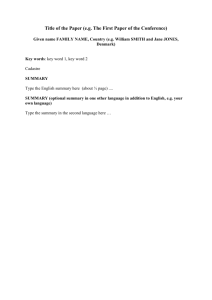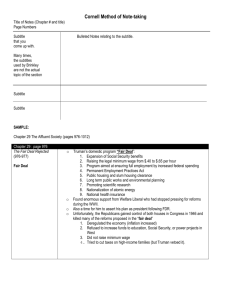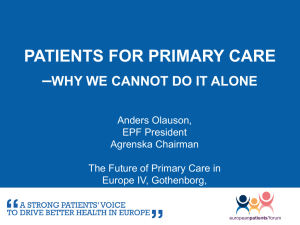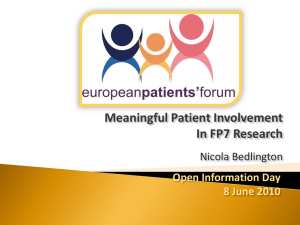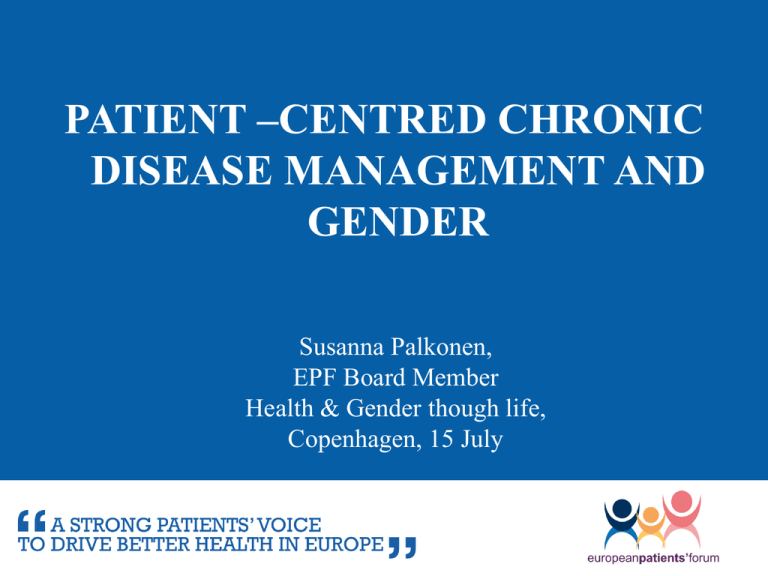
PATIENT –CENTRED CHRONIC
DISEASE MANAGEMENT AND
GENDER
Susanna Palkonen,
EPF Board Member
Health & Gender though life,
Copenhagen, 15 July
EPF About us
•
•
•
Independent, non-governmental
umbrella organisation set up in 2003
VISION: High-quality, patientcentred, equitable healthcare for all
subtitle
patients in the EU
MISSION: To provide a strong and
united patients’ voice –> Putting
patients at the centre of EU health
policy
54 member organisations – 150 million patients with
chronic conditions across the EU
Gender and chronic diseases
•
•
•
•
Significant differences in how men and women are affected by
chronic diseases : prevalence, degree of severity, symptomsbiological differences & gender aspects
Gender differences not only have a direct impact on the health
behaviour, exposures, social factors, but also on needs and
subtitle
access to care of women and
men.
Men are more likely to die, at all age, of all the causes of death
recorded by Eurostat; Women live longer, are more likely to
suffer illness and disability in later life
Governments and health systems do not always recognize of
address this sufficiently: health systems can also indirectly
contributes to gender inequalities in health.
Gender and chronic diseases
Gender dimension in:
1. Research & Clinical trials
2. Chronic disease management
subtitle
3. Informal carers/families
4. Health literacy/ communication and
information/ empowerment
5. Healthcare professional training
6. Role of patient organisations
1. Research & Clinical trials
Women and men are different in regards to their biological make-up
(sex). Gender is not related to biology; it refers to cultural issues: men
and women’s different roles and responsibilities in society, their access
to and control over resources, including information, and their decisionmaking power.” Value + project
•
subtitle
Gender imbalance in health
research both in content and
process (source: ENGENDER Project, policy brief gender imbalance in
health research)
-
-
Content: slow recognition that health problems affect men and
women differently, misdirected and incomplete approach to
men and women’s need, and lack of recognition of interaction
between gender and other social factor.
Process: e.g. lack of disagregated data in project, gender
imbalance in clinical trials, ethic committees, advisory bodies…
1. Research & Clinical trials (2)
•
•
Value + : explored gender and
patient involvement in EC health
related projects
Recommendations to better
integrate gender perspective:
subtitle
‐ Both men and women must be involved
‐
‐
actively to generate a rich and relevant
mix of approaches to health matters
Meaningful participation opportunities
should take account of gender
differences: e.g. men and women need to
be approached differently
Male and female participation should be
appropriate to the gender dimension of
project objectives and outcomes
“Health research in all areas
shows that gender factors have a
great influence on causes,
consequences and management
of diseases and ill-health.”
“Prevention, treatment,
rehabilitation and care delivery
often need to be adapted to the
gender of the people who will use
them” Value + Toolkit
1. Research & Clinical trials (3)
most research and clinical trials are done on
men and extrapolated to women
research on the kinds of treatment that are best
for women remains limited
• 2006 EMA document “ICH - Gender
considerations in clinical trials”
showed that
subtitle
women involved but less so in phase Phase I
and I-II studies. However, these are the studies
in which safety, safe dosage range and side
effects are determined
EPF calls on the EU institutions to ensure that the revision of the
clinical trial directive address this issue: beyond the question of
ethics- effectiveness and safety of medicines is at stake
2. Chronic disease management
Men and Women have different health behaviours- they both
have unmet needs, caused by different factors
Gender may affect the provision of secondary prevention,
treatment, management of a disease:
‐
‐
‐
‐
•
Gender labelling negative consequences on diagnosis and treatment (e.g.
CVD, osteoporosis)
subtitle
It may be affected by gender norms and stereotypes (e.g. mental health
diagnosis and treatment)
The EC reported that most comprehensive screening programmes are
targeting women’s health (in particular sexual and reproductive) and
women’s specific cancer – BUT both for men and women still wide
disparities in Member States in the availability of screening programmes
May affect other areas e.g. return to work
Health systems failures: due to lack of awareness/ recognition
among patients, healthcare professionals, and decision makers
3. Informal Care
most people providing informal care are women (2/3 according
to WHO)
Trend towards home care: potentially cost saving – key wish of
patients to remain independent for as long as possible- better
health outcomes.
subtitle
Need for adequate support and training of carers
Some existing support services, but generally informal carers do
not receive enough support and recognition
• Known effect on employment- little research on quality of life
and health of carers
• Recognising informal carers: counted in statistics, accounted for
in health economic representations, and taken into account
when policy is made.
4. Health literacy& empowerment
• Empowerment depends upon:
‐
‐
‐
High quality information to patients on treatment options, their disease and
other health issues – one size does not fit all
Health literacy: having the capacity to obtain, interpret and understand
health information; to make sound health decisions; and to navigate the
health services
subtitle
Enabling healthcare environment: organisation of health system can be
empowering or dis-empowering
• Women and men have different needs:
‐
‐
‐
Women act as pillar in the family for health, for children, as informal carers,
and for themselves
Men have lower understanding of health and prevention
For both groups- no homogeneity- gender may be combined with other
factors that affect their health literacy(education and culture, belonging to
an ethnic minority…)
4. Health literacy& empowerment
•
Need to use the right channels to provide information to men
and women
• Provide patients with information they want and need
• Key role of patient organisations :
‐ They regularly liaise with grassroots
subtitle patient communities that
they know well, thus they can help ensure that health
promotion and prevention messages are effectively
communicated.
‐ They can also reach out to populations with specific risk factors,
or patients with particular disease, and from diverse ethnic and
cultural patient groups.
EPF calls for comprehensive strategy on information to patients
at EU level that encompass health literacy
5. Health professionals’ training
•
•
‐
‐
‐
‐
Gender literacy of healthcare professional is a key issue, since
they have an important role to play in empowering patients to
participate in shared decision making, and contribute to building
a patients’ own health literacy.
The way gender is addressed in the content of medical and
subtitle
health care courses influences
healthcare professionals’ training
and therefore their future clinical practices.
HP need to be aware of how gender influences health outcomes and health
seeking behaviours.
They also need to be trained in communicating
more effectively with patients from both gender.
need for further availability of sex disaggregated
data
Continuing Professional Development
5. Role of patient organisations
•
•
•
•
Key role in providing user friendly information and putting in
place health literacy initiatives
Patients’ organisations can support health promotion efforts in
the community through facilitating community outreach,
community screening, and the development of community
subtitle
support.
Given the differences in the health systems in EU Member
States, patient organisations can play a highly effective role in
identifying interventions that work for different patient groups
in the different cultural and social contexts
Meaningful patient involvement in clinical trials (health related
research, in developing health related indicators, in health
programmes and policy is essential to ensure that they reflect
patients’ real needs
Final Thoughts
•
•
•
Gender is a universal factor and goes across other
dimension (e.g. socio-economic, religious,
cultural, ethnic, categories.) – need consider
gender alongside other diversity issues
subtitle on
EPF has formulated recommendations
meaningful patient involvement as part of the
Value + project which takes into account diversity
issue- we call on Member States and EU
institutions to implement them.
Women and men should be encouraged to
become equally involved in health matters that
affect them
THANK YOU FOR YOUR ATTENTION!
More information:
www.eu-patient.eu
info@eu-patient.eu

